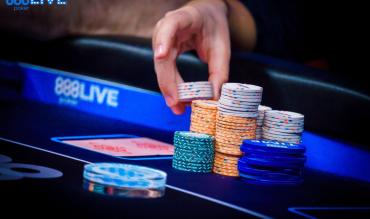Article updated on 5 February 2025
What does ‘limp’ mean in poker?
In the first betting round of poker—preflop—you have three choices: raise, limp, or fold.
- Raise: Increase the bet size.
- Limp: Call the minimum bet (the big blind—more on that in a moment).
- Fold: Discard your hand and sit out of the round.
Let’s break it down with an example:
Imagine you sit at a poker table where the blinds are $1/$3:
- The small blind ($1) and big blind ($3) are mandatory bets.
- The player in the small blind position must post $1.
- The player in the big blind position must post $3.
- These bets are required before players see their cards, so they’re called blind bets.
While the blinds must pay, everyone else at the table has a choice—raise, limp, or fold.
Here is what a raise or fold means:
Raise:
Increase the bet size from $3. It’s common to triple the bet size—a standard raise here might be to $9 or round up to $10.
Fold:
A lousy hand might not even be worth $3, let alone $10. Whatever the price, a player can choose not to pay it and fold their cards.
So, what is a limp in poker?
A limp in poker specifically refers to paying only the big blind—the absolute minimum bet.
You cannot limp in poker games if someone has already raised in front of you!
In this example, a poker limp would cost you precisely $3. Any other amount is not a limp (that would be either raising or calling someone else’s raise).

Limp Poker — The Three Types
There are different types of limping in poker depending on the action at the table (the other players do).
1). Open Limp:
We are the first person to limp.
2). Limp Behind/ Over Limp:
Limping behind, otherwise known as “over limping” in poker lingo, is when we limp preflop after a player has already limped before us.
3). Complete:
This option applies exclusively to small blind play. Unlike the other positions, the small blind does not need to invest a full big blind to make the call since they already have half a big blind invested. This player can simply “complete” the remaining half a big blind to call.
Should YOU Ever LIMP IN POKER?
Here’s some general advice:
- Open Limp:
- Limp Behind / Over Limp: Generally, not unless two or more players have limped in front of you and you don’t have a very strong hand. Even then, it’s questionable.
- Complete:
Why Shouldn’t You Limp in Poker?
What’s wrong with open limping?
When you limp in poker, you are immediately advertising to the table that you don’t feel confident about your poker hand. You are telegraphing that your cards are only worth paying the minimum.
That is why experienced players rarely open limp.

Even if you only have a medium hand, like a pair of sixes, it is better to portray confidence and open the action with a raise. Pretend your hand is worth $10!
Not only will this allow you to bluff later on more believably, but it will also disguise your hands better. Play a pair of sixes the same way you play a pair of kings.
If you only raise when you have a very strong hand and limp when you have a weak or medium hand, your cards will become way too obvious.
Thinking players will pick up on this pattern reasonably quickly and be able to sniff out your range.
What Strategy Makes The Most Money?
There’s another reason not to open limp: profitability.
When you open limp, other players are more likely to limp after you because the price to see a flop is cheap. This action is not a good thing!
Even if you have a hand as strong as pocket aces, you are not the favourite to win up against four or more players. No hand is. This reason is why it’s better to raise.

Here’s what open raising accomplishes:
Narrow the field:
When you start with a raise, you’re thinning the competition and mostly going to face fewer opponents — giving your hand a better mathematical likelihood of winning.
Build a pot:
When you increase the price with a raise, the pot will naturally grow. Raised pots tend to be bigger than limped pots. You’re setting yourself up to win more money.
Earn the betting lead:
Raising will earn you the betting lead, meaning other players will typically check to you on the flop. This play grants you more control over the hand.
Balance:
Raising with strong hands and your weaker poker combos disguises your cards and makes you tougher to play against.
Bluffability:
Raising makes your bluffs more believable. But if you start with an open limp, other players are going to have a hard time buying what you’re selling. This situation handicaps you, so you can only win by having the best hand.
Open limping puts you at the mercy of the deck. Raising gives you control!
When Limping in Poker Makes Sense (And When It Doesn't)

Limping is generally not recommended in poker, but there are two main exceptions:
1). Completing the Small Blind –
If you're in the small blind and multiple players have already limped, calling the extra chips to see a flop is justified. However, in tournaments, this strategy is debatable.
2). Over Limping –
If several players have limped before you, limping behind can sometimes be profitable, allowing you to see a cheap flop with speculative hands. The standard raise formula also requires you to raise roughly 3x the big blind plus one big blind for every limper.
If many people have limped, you would have to put in a hefty raise to narrow the field, which may not be appropriate for your hand or stack size.
That said, small blind limping isn't always ideal. Here’s a cool tip from poker coach John Bradley, who had over $1,000,000 in online tournament earnings.
After analysing hundreds of thousands of hands, he found that raising the small blind against a big blind opponent yielded a higher win rate than limping when everyone else had folded.
Limping in Poker - Conclusion
Limping in poker is widely misunderstood. While it may seem like a safe and low-risk way to see a flop, it puts you at a strategic disadvantage:
- Open limping signals weakness.
- It invites more opponents into the pot.
- And it reduces your ability to control the hand.
In contrast, raising preflop narrows the field, builds the pot, and establishes the betting lead. All of which contribute to long-term profitability and money-making.
The most potent poker strategy involves aggression, balance, and deception - not limping!
Originally published on 24 November 2018
See Also


